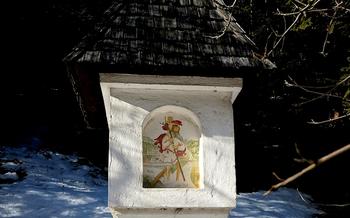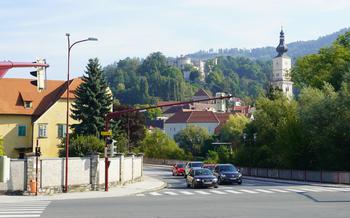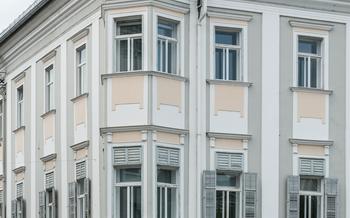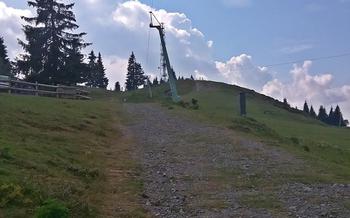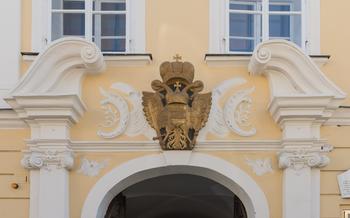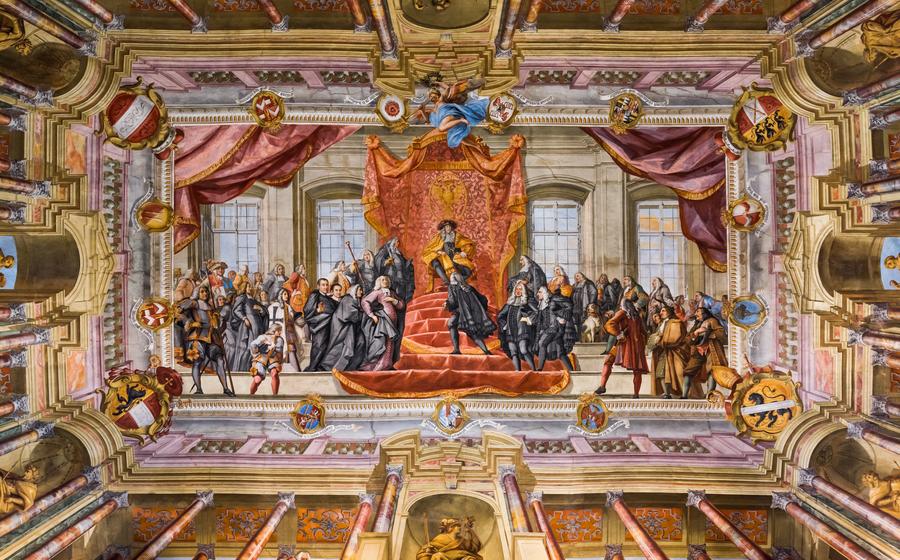
Landhaus
- History of the Landhaus
- Architectural Highlights
- The Carinthian Parliament
- Guided Tours
- Exhibitions and Events
- The Landhaus Courtyard
- The Carinthian Coat of Arms
- The Landhaus Chapel
- The Golden Hall
- The Carinthian Eagle: A Symbol of Strength and Independence
- The Landhaus Garden
- The Carinthian Parliament Library
- The Landhaus Archives
- The Landhaus Museum
- Insider Tip:
History of the Landhaus
Embark on a journey through time as you explore the Landhaus, a majestic Renaissance edifice that has witnessed centuries of Carinthian history. Built in the 16th century, it served as the residence of the Carinthian dukes before becoming the seat of the Carinthian Parliament. Admire its architectural splendor, characterized by symmetry, balance, and intricate details. Discover the stories behind its Renaissance-style arcade courtyard and ornate facade, which have stood the test of time. Learn about the significant events that have unfolded within its walls, including the signing of the Carinthian Plebiscite in 1920, which determined the fate of the region. Each stone, each arch, and each chamber holds a tale waiting to be told, inviting you to delve into the rich history of the Landhaus.
Architectural Highlights
The Landhaus stands as a testament to the grandeur of Renaissance architecture, characterized by its symmetry, balance, and intricate details. Its facade boasts beautiful arcades, columns, and pilasters that create a harmonious and visually appealing exterior. The impressive Renaissance portals are adorned with elaborate carvings and sculptures, showcasing the artistic prowess of the era. Inside, the Landhaus is adorned with stunning stained glass windows that depict religious scenes and historical events, casting a vibrant glow throughout the building.
These architectural elements combine to create a breathtaking masterpiece that transports visitors back in time. The Renaissance-style architecture of the Landhaus reflects the wealth, power, and cultural significance of Carinthia during the 16th century, and it continues to inspire and captivate visitors to this day.
The Carinthian Parliament
The Landhaus is not just a historical landmark but also the seat of the Carinthian Parliament, the legislative body of the state of Carinthia. The parliament consists of 36 members who are elected by the people of Carinthia every five years. The parliament is responsible for passing laws, approving the state budget, and overseeing the work of the state government.
Visitors to the Landhaus can observe parliamentary sessions and debates, if they are in session during your visit. This is a great opportunity to witness the democratic process in action and learn more about the political system of Carinthia. It is advisable to check the parliament's website or contact the Landhaus directly to confirm the schedule of sessions and to inquire about the possibility of attending as a visitor.
The Carinthian Parliament plays a crucial role in shaping the laws and policies of the state. It represents the interests of the Carinthian people and ensures that their voices are heard in the decision-making process. By observing parliamentary sessions and learning about the work of the parliament, visitors can gain a deeper understanding of the political landscape of Carinthia and the challenges and opportunities that the state faces.
Guided Tours
Make the most of your visit to the Landhaus by taking advantage of the guided tours offered by the building. These tours provide an in-depth exploration of the Landhaus' history, architecture, and significance, led by knowledgeable guides who are passionate about sharing their insights.
As you embark on the guided tour, you'll be captivated by the stories and anecdotes brought to life by your guide. Discover the hidden corners and secret passages of the Landhaus, accessible only to those who venture beyond the main thoroughfares. Learn about the various rooms and chambers within the building, each with its own unique function and significance in the history of Carinthia.
Through the guided tours, you'll gain a deeper understanding of the Carinthian Parliament and its role in shaping the laws and policies of the state. You'll witness firsthand the parliamentary sessions and debates that take place within the Landhaus, immersing yourself in the political discourse that shapes the future of Carinthia.
Whether you're a history buff, an architecture enthusiast, or simply curious about the inner workings of a government building, the guided tours of the Landhaus offer an unforgettable experience that will leave you with a profound appreciation for this architectural and historical treasure.
Exhibitions and Events
The Landhaus is not just a seat of government but also a vibrant cultural hub. Temporary exhibitions and events are frequently held within its walls, showcasing a diverse range of art, history, and culture. These exhibitions provide a unique opportunity to delve deeper into Carinthia's rich heritage and gain insights into contemporary artistic expressions.
From thought-provoking art installations to historical retrospectives, the exhibitions at the Landhaus cater to a wide range of interests. Discover the works of local and international artists, explore the fascinating history of Carinthia through interactive displays, or attend lectures, concerts, and workshops that delve into various aspects of Carinthian culture.
Make sure to check the Landhaus website or inquire at the tourist information office for the latest exhibition schedule. These events offer an excellent chance to engage with the local community, learn about Carinthian traditions, and experience the vibrant cultural scene that Klagenfurt has to offer.
The Landhaus Courtyard
In the heart of Klagenfurt, amidst the bustling streets and vibrant atmosphere, lies a hidden gem that offers a tranquil escape—the Landhaus Courtyard. Step through the archway and enter a world of serenity, where time seems to slow down and the beauty of Renaissance architecture unfolds before your eyes.
The courtyard is a masterpiece of symmetry and balance, with arcades and ornate windows framing a tranquil fountain and lush greenery. The Renaissance-style architecture that surrounds the courtyard is a testament to the craftsmanship and artistry of the era. Take a moment to admire the intricate details of the columns, pilasters, and carvings that adorn the walls, each element contributing to the overall harmony of the space.
Find a bench beneath the shade of the trees and let the peaceful atmosphere wash over you. Enjoy a picnic lunch or a cup of coffee as you soak up the tranquility of the courtyard. Allow your mind to wander as you listen to the gentle sound of the fountain and the birdsong that fills the air.
The Landhaus Courtyard is a true hidden gem, a place where you can escape the hustle and bustle of city life and find a moment of peace and tranquility. Whether you're seeking a place to relax and recharge or simply want to admire the beauty of Renaissance architecture, the Landhaus Courtyard is a must-visit destination in Klagenfurt.
The Carinthian Coat of Arms
Displayed prominently on the facade of the Landhaus, the Carinthian coat of arms is a symbol of the state’s unique identity. The coat of arms features a black panther and a golden eagle, each with its own symbolic meaning. The black panther represents strength, courage, and independence, while the golden eagle symbolizes wisdom, power, and majesty. Together, the two animals represent the harmonious coexistence of different cultures and traditions in Carinthia.
The coat of arms has a long and rich history, dating back to the 13th century. Over the centuries, it has undergone several modifications, reflecting the changing political and cultural landscape of Carinthia. However, the basic elements of the coat of arms have remained the same, ensuring its continuity as a symbol of Carinthian identity.
The intricate details and craftsmanship of the coat of arms are a testament to the skill and artistry of its creators. The animals are depicted with remarkable precision and realism, capturing their strength and grace. The coat of arms is a true work of art, and it is a source of pride for the people of Carinthia.
The Landhaus Chapel
Nestled on the first floor of the Landhaus, the Landhaus Chapel offers a serene sanctuary for reflection and spiritual contemplation. Dedicated to Saint George, the patron saint of Carinthia, the chapel exudes an aura of tranquility and devotion.
Adorned with exquisite stained glass windows, the chapel's interior is a testament to the artistry and craftsmanship of its creators. The windows depict vivid scenes from the life of Saint George and other saints, casting a warm and colorful glow upon the chapel's interior.
Visitors can learn about the history of the chapel and its significance in the religious life of the Carinthian Parliament. It served as a place of worship and contemplation for the members of the parliament, offering them a sanctuary for spiritual guidance and solace.
Take a moment to step inside the Landhaus Chapel and immerse yourself in its peaceful atmosphere. Let the stained glass windows transport you to a realm of faith and devotion, and find a moment of tranquility amidst the grandeur of the Landhaus.
The Golden Hall
Step into the Golden Hall, one of the most impressive rooms in the Landhaus, and be captivated by its stunning gold-leaf decorations that adorn the walls and ceiling. This magnificent hall has served as a grand venue for important ceremonies and events throughout Carinthia's history. Take a moment to admire the intricate paintings and sculptures that grace the hall, each narrating a unique story. Immerse yourself in the grandeur of this opulent space and feel the weight of its historical significance.
The Carinthian Eagle: A Symbol of Strength and Independence
As you explore the Landhaus, keep an eye out for the Carinthian eagle, a symbol of the state of Carinthia that is prominently displayed throughout the building. The eagle, with its outstretched wings and piercing gaze, represents strength, independence, and the proud spirit of the Carinthian people.
Its history dates back to the 13th century when it was adopted as the symbol of the Duchy of Carinthia. Over the centuries, the eagle has become an iconic emblem, appearing on the Carinthian coat of arms, flags, and official documents.
Within the Landhaus, you will find the Carinthian eagle depicted in various forms, from sculptures and paintings to elaborate carvings. Each representation tells a unique story, showcasing the artistic and cultural significance of this majestic bird.
Take a moment to appreciate the intricate details and craftsmanship of the Carinthian eagle. Its powerful presence adds to the grandeur of the Landhaus and serves as a reminder of the rich history and identity of Carinthia.
The Landhaus Garden
Take a moment to escape the hustle and bustle of Klagenfurt and explore the serene Landhaus Garden, a hidden gem located behind the Landhaus building. As you step through the gate, you will be greeted by a tranquil oasis, a verdant sanctuary in the heart of the city.
Wander along the winding paths, admiring the vibrant colors of the flowers, the lush greenery of the trees, and the delicate sculptures that adorn the garden. Take a seat on a bench and soak up the peaceful atmosphere, letting the sounds of nature wash away your worries.
Discover the hidden treasures of the Landhaus Garden, such as the rose garden, where you can marvel at the beauty of hundreds of roses in bloom, and the herb garden, where you can learn about the various herbs grown for culinary and medicinal purposes.
Whether you are seeking a place to relax and recharge, or simply want to explore the beauty of nature, the Landhaus Garden is a must-visit destination in Klagenfurt.
The Carinthian Parliament Library
The Carinthian Parliament Library is a treasure trove of knowledge and history, housing a vast collection of books, documents, and manuscripts related to the history and culture of Carinthia. Established in the 19th century, the library serves as a center of research and scholarship, attracting scholars and researchers from around the world.
The collection includes rare and valuable books dating back to the 16th century, as well as legal texts, maps, and manuscripts that shed light on Carinthia's rich past. Visitors can explore the library's holdings and discover fascinating insights into the political, social, and cultural history of the region.
The library is open to the public, and visitors are welcome to browse the shelves or conduct research in the reading room. The knowledgeable staff is always ready to assist visitors and provide guidance in finding the resources they need.
Whether you are a history buff, a researcher, or simply someone with a thirst for knowledge, the Carinthian Parliament Library is a must-visit destination. Its collection offers a wealth of information and insights into the history and heritage of Carinthia, providing a deeper understanding of this fascinating region.
The Landhaus Archives
Delve into the Landhaus Archives, a treasure trove of historical documents and records that offer a glimpse into Carinthia's rich past. Established in the 16th century, the archives house a vast collection of manuscripts, charters, maps, and legal texts that shed light on the administrative and political history of the state.
As you explore the collection, you'll discover medieval charters that document the early history of Carinthia, legal texts that provide insights into the development of the Carinthian legal system, and maps that depict the changing boundaries of the state over the centuries. The archives also hold personal papers and correspondence of prominent Carinthian figures, offering a glimpse into their lives and contributions to Carinthian society.
Whether you're a history buff, a researcher, or simply curious about Carinthia's heritage, the Landhaus Archives are a must-visit. With its wealth of historical documents and knowledgeable staff, the archives provide a unique opportunity to explore the fascinating story of Carinthia and its people.
The Landhaus Museum
The Landhaus Museum, situated on the ground floor of the magnificent Landhaus, offers a captivating journey through the history and significance of this iconic building. As you step inside, you'll be greeted by a treasure trove of exhibits that showcase the Landhaus's construction, architectural features, and its pivotal role in Carinthian politics and culture.
Through a diverse collection of artifacts, documents, and scale models, the museum brings to life the stories of the Landhaus's past. Learn about the vision behind its construction, the skilled craftsmanship that went into its design, and the remarkable events that have unfolded within its walls.
Don't miss the interactive displays that allow you to engage with the Landhaus's history in a fun and educational way. Touchscreens, multimedia presentations, and hands-on exhibits provide a deeper understanding of the building's significance and its impact on the region.
Whether you're a history buff, an architecture enthusiast, or simply curious about the Landhaus's legacy, the Landhaus Museum is a must-visit destination. Immerse yourself in the rich heritage of this architectural masterpiece and gain a deeper appreciation for its enduring importance to Carinthia.
Insider Tip:
To avoid the crowds and enjoy a more peaceful visit to the Landhaus, plan your trip outside of the peak tourist season, which typically runs from July to August. During the shoulder seasons (May-June and September-October), you'll still be able to enjoy pleasant weather while avoiding the large tour groups and long lines. Additionally, visiting the Landhaus on a weekday rather than a weekend can also help you beat the crowds. This will give you more time to explore the building, admire its architectural details, and soak up the atmosphere without feeling rushed.
